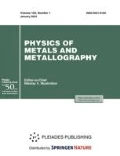Abstract
The influence of heat treatment in air on the level of magnetic properties has been studied on the example of a ribbon of an amorphous cobalt-based (Co–Fe–Ni–Cr–Si–B) soft-magnetic alloy with a nearzero saturation magnetostriction. The investigation of the interaction of the ribbon surface with water and water vapor and its influence on the magnetization distribution showed the possibility of applying surface treatment to determine the sign of saturation magnetostriction. The sign of saturation magnetostriction in the initial (quenched) state confirmed the presence of a negative magnetostriction in the ribbon. Based on the results obtained, the dependence of the sign of saturation magnetostriction on the structural state that is obtained upon heat treatment has been revealed.
Similar content being viewed by others
References
F. Luborsky and J. Walter, “Stress relaxation in amorphous alloys,” Mater. Sci. Eng. 35, 255–261 (1978).
T. Mizoguchi, S. Hatta, and H. Kato, “Effects of annealing and fabrication conditions on the magnetic properties of the magnetic amorphous alloys,” IEEE Trans. Magn. 16, 1147–1149 (1980).
T. Hiroshi, “Annealing influence of magnetic permeability of Co–Fe–Mo–Si–B amorphous alloy,” Proc. 4th Int. Conf. Rapid Quench. Met., Ed. by T Masumoto and K. Suzuki (Japan. Inst. Met., Sendai, 1982), vol. 2, pp. 1051–1054.
T. Masumoto, “Designing the composition and heat treatment of magnetic amorphous alloys,” Mater. Sci. Eng. 48, 147–165 (1981).
A. L. Greer, “Atomic transport and structural relaxation in metallic glasses,” J. Non-Cryst. Solids 61, 737–748 (1984).
Y. Wang, “Structural changes during heating of amorphous alloy Co–Ni–Fe–B–Si,” J. Non-Cryst. Solids 54, 187–191 (1983).
N. A. Skulkina, O. A. Ivanov, E. A. Stepanova, L. N. Shubina, P. A. Kuznetsov, and A. K. Mazeeva, “Mechanisms of the formation of magnetic characteristics of a cobalt-based amorphous magnetically soft alloy under heat treatment in air,” Phys. Met. Metallogr. 116, 1182–1189 (2015).
O. G. Ivanov, “Formation of physical properties and development of new amorphous soft-magnetic alloys based on cobalt,” Extended Abstract of Candidate’s (Eng.) Dissertation, Mos. Gos. Technol. Univ., Moscow, 2003.
I. B. Kekalo and P. S. Mogil’nikov, “Effect of bending stresses on the high-frequency magnetic properties and their time stability in a cobalt-based amorphous alloy with an extremely low magnetostriction,” Tech. Phys. 60, 1815–1822 (2015).
N. A. Skulkina, O. A. Ivanov, and I. O. Pavlova, “Effect of electrolytic oxidation and hydrogenation on the magnetization distribution and magnetic properties of ribbons of amorphous soft magnetic iron-based alloys,” Phys. Met. Metallogr. 112, 458–463 (2011).
N. A. Skulkina and O. A. Ivanov, Soft-magnetic Materials. Physical Interactions and Magnetic Properties (Lambert Academic, Saarbrucken, 2010).
N. A. Skulkina, O. A. Ivanov, and E. A. Stepanova, “Estimating calculation of magnetization distribution in ribbons of amorphous soft-magnetic alloys,” Izv. Ross. Akad. Nauk, Ser. Fiz. 65, 1483–1486 (2001).
https://www.catalogue.roselgroup.ru/
N. A. Skulkina, O. A. Ivanov, I. O. Pavlova, and O. A. Minina, “Time of isothermal holding in the course of in-air heat treatment of soft magnetic Febased amorphous alloys and their magnetic properties,” Phys. Met. Metallogr. 112, 583–588 (2011).
N. A. Skulkina, O. A. Ivanov, I. O. Pavlova, and O. A. Minina, “Interaction of the surfaces of ribbons of amorphous magnetically soft alloys with vapor at various stages of heat treatment,” Phys. Met. Metallogr. 116, 979–986 (2015).
Author information
Authors and Affiliations
Corresponding author
Additional information
Original Russian Text © N.A. Skulkina, O.A. Ivanov, E.A. Stepanova, O.V. Blinova, P.A. Kuznetsov, A.K. Mazeeva, 2016, published in Fizika Metallov i Metallovedenie, 2016, Vol. 117, No. 10, pp. 1015–1022.
Rights and permissions
About this article
Cite this article
Skulkina, N.A., Ivanov, O.A., Stepanova, E.A. et al. Effect of heat treatment in air and a chemically active environment on the magnetic properties of cobalt-based soft magnetic amorphous alloys. Phys. Metals Metallogr. 117, 982–989 (2016). https://doi.org/10.1134/S0031918X16100124
Received:
Accepted:
Published:
Issue Date:
DOI: https://doi.org/10.1134/S0031918X16100124



